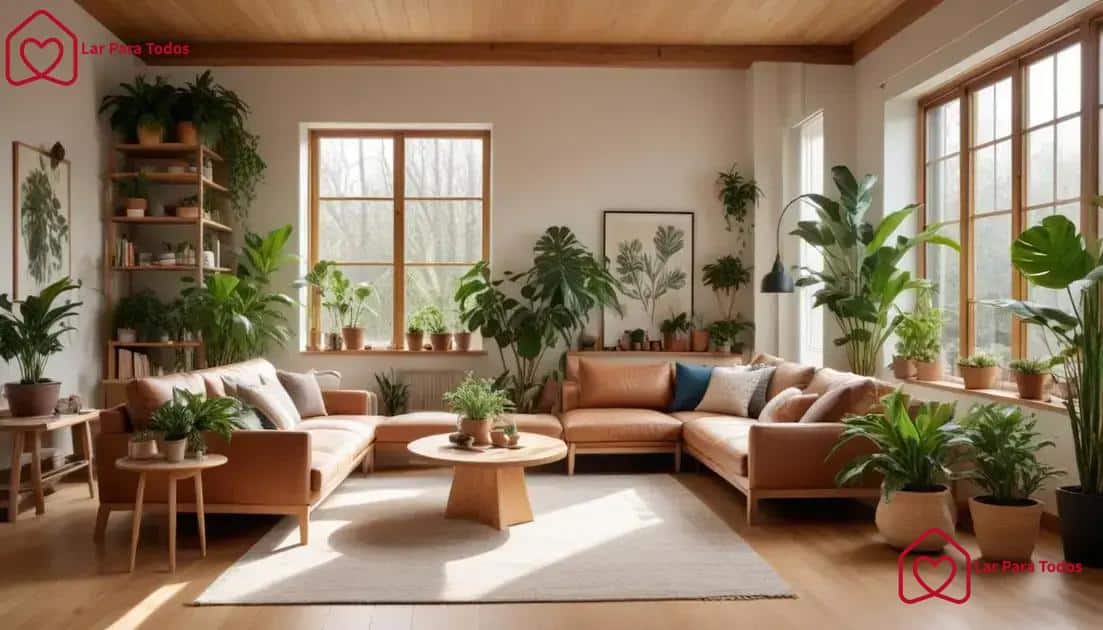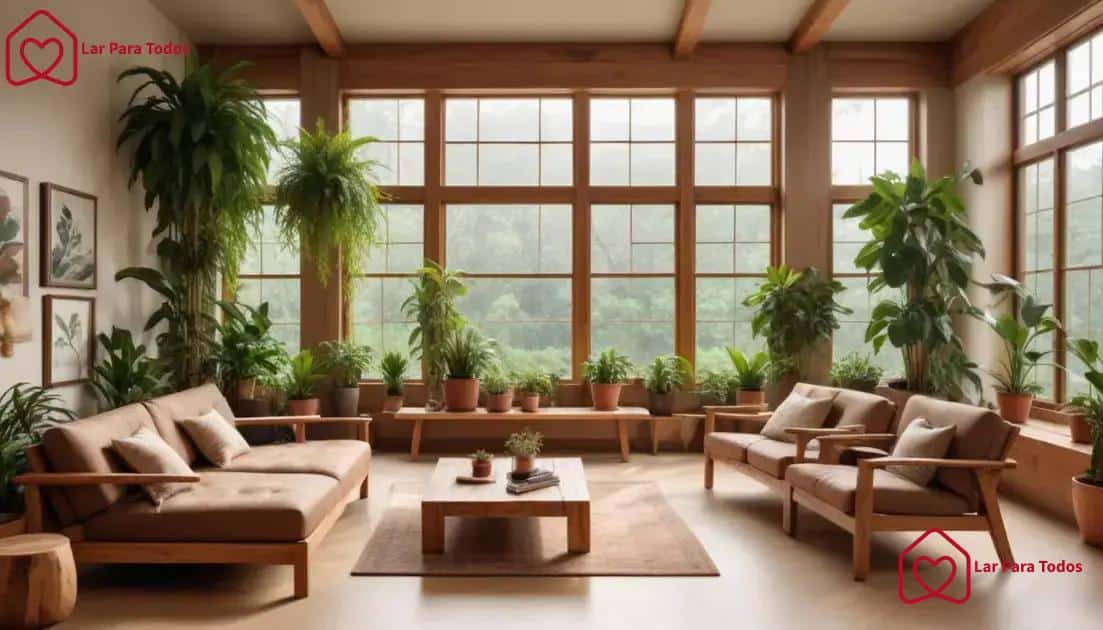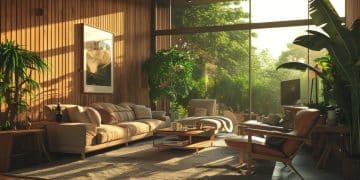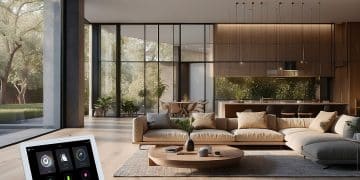Biophilic design at home: easy steps for nature lovers

Biophilic design at home enhances your living space by integrating plants, natural light, and organic textures that create a soothing atmosphere. These elements promote well-being and support a calmer daily life.
Biophilic design at home brings the beauty of nature indoors, helping transform ordinary rooms into peaceful retreats. Have you considered how greenery and sunlight can improve your mood and energy?
Let’s explore simple ways to create a nature-inspired environment that feels restorative. With a few thoughtful choices, your home can feel more connected to the outdoors.
Understanding biophilic design
Understanding biophilic design can transform your home into a tranquil oasis full of natural harmony. This approach uses nature-inspired elements to encourage calmness and joy.
Biophilic design reconnects us with nature when daily life keeps us indoors, improving clarity and comfort. These choices are proven to boost mental health and emotional balance.
Including natural materials and greenery can enhance mood, reduce stress, and increase productivity. It blends beauty and purpose for a balanced interior experience.
Core Elements of Biophilic Design
Natural light brings daylight into your space, reducing reliance on harsh artificial lighting. This brightens rooms and enhances well-being.
Greenery improves air quality and makes rooms feel livelier, adding organic texture throughout. Plants help create inviting, rejuvenating spaces.
Natural materials like wood and stone add warmth and gently connect interiors to the outdoors. These elements foster grounding energy.
Incorporating Biophilic Design into Your Home

Start by assessing your rooms and identifying ways to add greenery, texture, and sunlight. Small adjustments can create meaningful change.
Place plants around high-traffic areas or use natural fabrics for subtle transformation. These tweaks add freshness and life indoors.
Position furniture toward windows to maximize views of nature and outdoor scenery. This helps bring peace and visual relaxation.
Benefits of bringing nature indoors
Bringing nature indoors offers powerful benefits that elevate your home experience. Natural elements can help reduce stress and restore balance.
Even small changes at home can improve mood, lowering anxiety and refreshing your mindset. Nature stimulates creativity and calm.
These benefits extend beyond aesthetics, supporting healthier habits and emotional well-being. Nature nurtures both body and mind.
Physical Health Improvements
Plants purify indoor air, removing toxins and refreshing enclosed environments. Better air supports respiratory health.
Humidity from plants helps reduce dryness, improving skin and breathing quality. This creates more comfort year-round.
Natural textures and greenery help soften noise and promote a quieter environment. This enhances relaxation in busy homes.
Emotional Well-being
Plants bring joy, sparking positive energy and emotional connection to surroundings. Their presence encourages uplifting feelings.
Nature-inspired spaces remind us of peaceful outdoor moments and cherished places. This connection eases daily stress.
Seeing natural elements throughout your home encourages relaxation and optimism. This fosters a stable, calming atmosphere.
Easy steps to incorporate biophilic design
Incorporating biophilic design can be simple and rewarding, even with minimal changes. Start small and expand gradually.
Adding plants is an easy first step that instantly makes spaces feel more alive. Choose low-maintenance varieties that suit your lifestyle.
Arrange greenery in corners, on shelves, or in hanging planters for visual interest. These displays transform your daily view.
Use Natural Materials
Use natural materials such as wood, stone, or bamboo to introduce warmth and texture. These choices enrich interiors organically.
Wood accents and bamboo finishes add softness and a welcoming feel. They also pair well with neutral tones.
Stone elements provide visual grounding, connecting rooms to natural landscapes. They enhance depth and tactile appeal.
Incorporate Color and Texture
Earthy hues like greens, browns, and creams create a serene foundation. These tones mirror outdoor environments beautifully.
Layering textures inspired by nature—smooth stone, woven fabrics—brings dimension. This enhances comfort and visual balance.
Position furniture toward windows or nature-themed art to mimic outdoor views. This boosts calm and inspiration.
Common materials for biophilic interiors
Choosing natural materials is essential for creating authentic biophilic spaces at home. These materials enhance sensory comfort.
Wood, whether reclaimed or new, brings warmth and visual character into rooms. Its grain creates gentle organic movement.
Use wood for flooring, shelving, or decorative objects to integrate nature effortlessly. Each piece adds grounding energy.
Stone and Natural Textures
Stone provides an earthy presence with long-lasting durability and elegance. It brings a feeling of stability indoors.
Use granite or marble for surfaces to add polished detail and natural flair. Slate also creates balance and subtle depth.
Natural fabrics such as cotton, linen, and wool add softness and warmth. These textiles encourage touch and comfort.
Greenery and Living Walls
Plants are foundational to biophilic design, offering life and color indoors. They connect your home to nature instantly.
Use potted plants, hanging planters, or a living wall to increase visual impact. These features enhance energy flow.
Large windows or glass doors extend indoor-outdoor connection and bring sunlight. They make spaces feel bright and open.
Creating a personalized biophilic space
Making a personalized biophilic space begins with identifying natural elements you love most. These preferences guide your design.
Select plants, colors, and textures that reflect your style and emotional needs. This makes home feel more meaningful.
Even small additions, like succulents or floral arrangements, create refreshing visual anchors. Nature encourages creativity.
Incorporating Natural Sound and Smell

Soft sounds from water features can create calming sensory experience at home. This adds tranquil background rhythm.
Natural scents from essential oils evoke forests, citrus, or seaside breeze. These aromas foster immersive relaxation.
Candles with gentle fragrances enhance coziness and deepen the feeling of nature indoors. Choose clean, eco-friendly blends.
Personal Touches and Sustainability
Personal artwork inspired by nature helps express emotion and memory. These pieces strengthen visual connection.
Photos of outdoor landscapes add narrative and grounding to your rooms. They encourage calm reflection.
Sustainable decor supports the environment and aligns with biophilic values. Choose reclaimed materials when possible.
FAQ – Frequently Asked Questions about Biophilic Design at Home
What is biophilic design?
Biophilic design is an approach that seeks to connect people with nature through the use of natural elements in indoor spaces.
How can I start incorporating biophilic design in my home?
Start by adding indoor plants, using natural materials, and maximizing natural light in your living spaces.
What are some benefits of bringing nature indoors?
Bringing nature indoors can reduce stress, improve mood, and enhance overall well-being by creating a calming environment.
What materials are ideal for biophilic design?
Ideal materials include wood, stone, and natural fabrics, as they help create a warm and inviting atmosphere.





